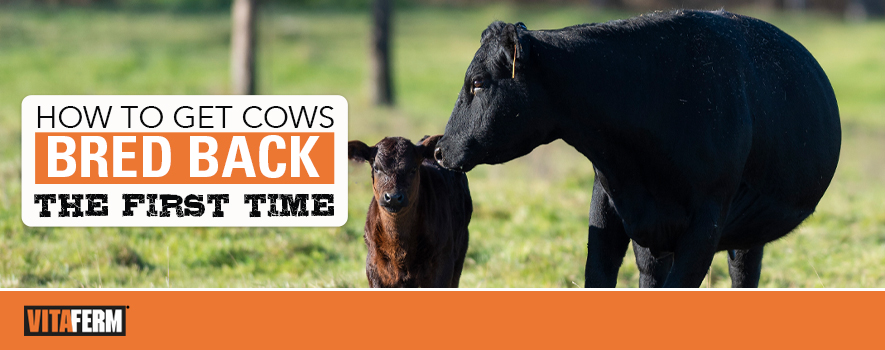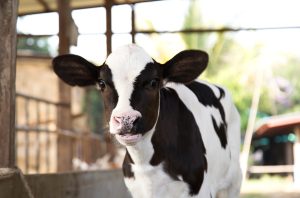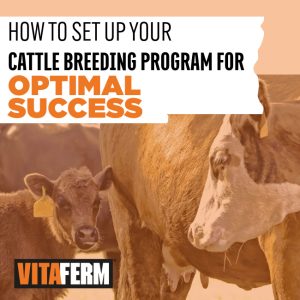Bringing a new life into the world is perhaps one of the most exciting moments ever. However, it can be one of the most stressful too, because no matter how many books you read or classes you take, there is nothing to prepare you. That statement is true for humans, but even truer for the first time-heifers calving in your cow herd.
But, imagine being a first-time cow that’s just given birth. She’s adjusting to her role as a mama, trying to provide the best nutrients possible to her calf, all while taking care of herself and maintaining her own still growing body. And, in 45-60 days, you are going to expect her to cycle and get her to breed back with calf number two. She’s going to need some help with all this multi-tasking, and will rely heavily on you, the producer, to assist her so she can be as reproductively efficient as possible.
Make Wise Breeding Choices the First Time
Prepare your first-calf heifers for an easier first-time delivery, which leads to an easier recovery. With a simpler recovery, this will help their reproductive system heal more quickly and be ready for breed-back. The best way to have an easy delivery, is to breed the heifers to low-birth weight, calving ease bulls.
“I think it is really important on first-calf heifers, to breed them to low-birth weight bulls to help minimize the shock to their system. Giving birth to a 65-pound calf versus a 102-pound calf is much easier on her,” said John Jeffrey, Area Sales Manager for BioZyme® Inc.
Evaluate Body Condition
Heading into the final trimester of gestation, make sure your first-calf heifers are setting at a body condition score between 5 and 6. Considered optimum BCS, this will allow them to calve with ease, under all other good management practices, continue to maintain a good condition and be in optimum condition when it comes time to rebreed. Jeffrey reminds producers that you don’t want your cows too thin or too obese at breeding time, because both physical conditions can cause challenges for breeding.
Keep them Separate
Many producers will manage their first-calf heifers separately from their mature cows in order to make sure they have the nutrition and care they need. Remember, these young females that aren’t quite 2 years old, are still growing and developing themselves, all while developing their first calf in the womb.
You might supplement their diets with a TMR, give them additional hay or just keep them closer to home to assist with any calving challenges these first-timers might experience. Often times, providing them with additional nutrition will help boost their BCS to the level needed, and help them be in better shape when it comes time to nurse and start healing and preparing for breed-back.
Manage their Health
Regardless if they are first-calf heifers or a mature cow, every breeding-aged female needs to have a proper vaccination and herd health protocol established. Be sure to work with your local veterinarian to know when to administer your vaccines. You will want to have a parasite control program that will help keep your herd healthy and eating.
Test your Hay
Jeffrey emphasizes the importance of testing all available forages and feedstuffs early on, so the producers know which hay to feed when, and how to best supplement the herd at the various stages of production. Just because it looks like you’ve got a good cutting of hay, doesn’t mean it is packed with nutrients; and just because it doesn’t look like the best cutting, doesn’t mean it isn’t a good-quality hay.
Producer and BioZyme® dealer Andy McLaughlin, Redfield, Iowa, is proactive in his feed and forage testing and believes it is a cost savings that allows him to plan his long-term feed and nutrition strategy. He has been testing his feed and planning his rations this way for at least six years. As part of the BioZyme dealer network, it is something he offers to all of his customers as well to help them increase efficiencies in their operations. BioZyme will run the analysis for its customers, and its nutritionists will work to calculate rations based on your feed supplies.
“Taking samples is really easy for the return. It takes a minute a sample, send it off and in 3-5 days I usually have results back. In that same amount of time the nutritionists have rations built for you,” McLaughlin said.
“Producers need to get all hay tested so they can make the best decisions about feed and supplementation through the wintertime, helping them maximize their dollars and stretch their resources,” Jeffrey said.
Choosing the Right Supplement
“The demands on the new mothers’ body, especially those 3-4 months in the last trimester and during birth and getting that calf going are going to be the greatest they will ever be on her body. Considering those factors, and how to keep your cow in good body condition through calving and back through breed-back is very important. That is why it is very vital to have those cows on a good mineral program. If you think about any of our VitaFerm® Concept•Aid® minerals, they are supercharged 2.5 times the NRC,” Jeffrey said.
The VitaFerm Concept•Aid mineral line contains Amaferm®, a precision prebiotic that is research-proven to impact intake, feed digestibility and nutrient absorption for optimum health and performance. In addition, it provides 5% phosphorus, the ideal level of phosphorus for use with average- to good-quality forages, to promote milk production and higher calf weaning weights. And the increased levels of vitamin E and selenium promote optimized fertility and help her reproductive tract heal faster so when it does come time to rebreed, she’ll be ready to roll.
“It is really important to be on a good mineral program that has Amaferm in it that allows her to utilize and breakdown and digest and absorb all those nutrients she needs better than she could without the Amaferm,” Jeffrey said.
New mama cows face several challenges: giving birth, their first lactation and raising that calf, all while trying to heal up and prepare for breed-back. As first-time calvers, their body has never gone through that, and it takes some great management, good health protocols and a high-quality nutrition program to prepare them for every challenge they will face.



